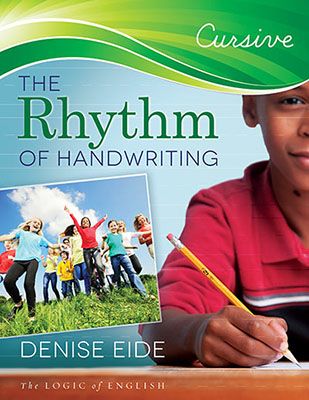
- The Logic of English
- Rhythm of Handwriting – Cursive
- $15.00 Print Edition also available as a PDF file
- Denise Eide – Author
- Ages: Kindergarten and up
About the Product
The Rhythm of Handwriting begins by teaching all the lowercase letters. The reasoning behind this is that since 90% of what we read and write is lowercase, learning them first provides students with the information they need to be successful in learning to read and write.
The Rhythm of Handwriting uses four learning modes: seeing, hearing, doing and speaking. First the student is shown how to form the letter. They hear the instructions orally. Then the student is asked to repeat the action (doing) as well as narrate what steps they are taking (speaking).
Large Motor Movements are initiated first. The motion originates in the elbow and helps establish the sequence of movement for each letter. The Rhythm of Handwriting book provides enlarged handwriting lines so students can first practice the letter with their pointer finger. It is encouraged to let the student practice with markers on individual white boards, sensory boxes or chalk.
Explicit instructions are given on how each letter is formed. Key words provide abbreviated directions that students can remember to help with the natural rhythm of each letter. Rhythm is emphasized so that students learn to have their pencil continue in a steady motion.
ClarkClan Experiences
Rebekah, 10, used the Rhythm of Handwriting book. She had been introduced to cursive writing, but only knew a few letters. She has been wanting to learn cursive and has been very enthusiastic during this review.
We would introduce the letter to learn and have her practice with her pointer finger. Then I would have her practice that letter with her pen on the provided pages. These pages have varying size lines so kids can use which one they prefer. We had Rebekah use each size so she could learn how to write in different sizes. It takes us about 15 minutes a day to work on her cursive.
We also used a “sensory pan” to practice each letter. This was simply a jelly roll pan that I poured rice into. She would write the letter with her pointer finger in the rice. Sidewalk chalk outside also was a fun activity to learn the letters. The last idea Rebekah came up with all on her own.. We had bought large pads of paper at a clearance sale. Rebekah decided to use these large lines to practice her cursive letters.
ClarkClan Recommendation
I found this to be a very adequate book for teaching cursive handwriting. It is not flashy, but simply a two page spread teaching how to form each letter in words, then forming the letter with the pointer finger, then eight lines of practice in varying widths. Rebekah is motivated to learn cursive and she took this book seriously. She told me she liked learning each letter, but true to Rebekah nature, thought there was too much practice.
I would recommend this book for teaching cursive. The instructions are clear and concise. It is a good, no frills way to easily teach a beautiful script.

The Logic of English produces many homeschool products. The Schoolhouse Review Crew not only reviewed The Rhythm of Handwriting but also reviewed their Essentials program and Foundations program for teaching reading and writing along with an i-Pad app. Visit the Crew Blog to read what other reviewers thought of The Logic of English programs.





No comments:
Post a Comment